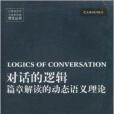《對話的邏輯:篇章解讀的動態語義理論》是2010年北京大學出版社出版的圖書,作者是埃舍(Nicholas Asher) 萊斯卡里達斯(Alex Lascarides)。
基本介紹
- 中文名:對話的邏輯:篇章解讀的動態語義理論
- 作者:埃舍(Nicholas Asher) 萊斯卡里達斯(Alex Lascarides)
- 出版社:北京大學出版社
- 出版時間:2010年8月1日
- 頁數:526 頁
- 開本:16 開
- ISBN:9787301171585, 7301171587
- 外文名:Logics of Conversation
- 語種:英語
內容簡介,圖書目錄,作者簡介,序言,
內容簡介
《對話的邏輯:篇章解讀的動態語義理論》:計算語言學與語言科技原文叢書。
《對話的邏輯:篇章解讀的動態語義理論》在語言科學與信息科學的研究領域扮演關鍵性的角色。語言學理論尋求對語言現象規律性的揭示與完整的解釋。計算語言學正好提供了驗證與套用這些規律與解釋的大好機會。作為語言學、信息科學乃至於心理學與認知科學結合的交叉學科,計算語言學更提供了語言學基礎研究與套用研究的絕佳界面。事實上,計算語言學與人類語言科技(Human Language Technology,HLT)可以視為一體兩面,不可分割。計算語言學研究濫觴於上世紀五六十年代的機器翻譯研究。中文的相關研究也幾乎同步開始,1960年起在柏克萊加州大學研究室,王士元、鄒嘉彥、C.Y.Dougherty等人已開始研究中英、中俄機器翻譯。他們的中文計算語言學研究,可說是與世界最尖端科技同步的。中國國內中俄翻譯研究也不遑多讓,大約在上世紀50年代中期便已開始。可惜的是,這些中文相關早期機器翻譯研究,由於硬體與軟體的限制,沒能延續下來。中文計算語言學研究比較有系統的進展,還要等到1986年;海峽兩岸在同一年成立了兩個致力於中文計算語言學基礎架構建立的研究群。北京大學的計算語言學研究所在朱德熙先生倡導下成立,隨後一段時間由陸儉明、俞士汶主持。而台灣“中研院”的中文詞知識庫小組,由謝清俊創立,陳克健主持,黃居仁1987年返台後加入。
圖書目錄
導讀
Preface
Figures
Acknowledgements
Motivations
1.1 What This Book is, and is Not, About
1.2 Motivating Rhetorical Relations
1.2.1 Temporal Structure
1.2.2 Anaphora and VP Ellipsis
1.2.3 Bridging
1.2.4 Presuppositions
1.2.5 Lexical Ambiguity
1.2.6 Implicature in Dialogue
1.3 Rhetorical Relations in Corpora
1.4 Conclusions
2 Semantic Models of Discourse Interpretation
2.1 Introduction
2.2 Dynamic Semantics
2.3 DRSS. Syntax and Semantics
2.3.1 A Basic Fragment
2.3.2 The Semantics of DRSS
2.3.3 Questions
2.3.4 Requests
2.4 Construction and Underspecification
2.5 Why Dynamic Semantics is Not Enough
2.5.1 Anaphora
2.5.2 Temporal Anaphora
2.5.3 Presuppositions
2.6 Conclusion
3 Pragmatic Models of Discourse Interpretation
3.1 Introduction
3.2 Traditional Theories of Pragmatics
3.2.1 Relevance Theory
3.2.2 Against The Belief Change Model of Discourse Content
3.3 Cognitive Approaches to Discourse Interpretation
3.3.1 Plan Recognition and Discourse Structure
3.3.2 Interpretation as Abduction
3.4 Other Theories that Use Rhetorical Relations
3.5 Empirical Approaches to Discourse Interpretation
3.6 Some Concluding Remarks
4 The Logical Form of Discourse
4.1 Introduction
4.2 Underspecification and Pragmatic Supplementation
4.3 Underspecified Logical Forms for Clauses
4.3.1 Other Sources of Underspecification
4.3.2 The Syntax of ULFS
4.3.3 The Interpretation of ULFs
4.4 The Syntax of the Discourse Language
4.4.1 A General Approach to Syntax
4.5 A Language for Describing Logical Forms
4.6 The Vocabulary of Discourse Relations
4.7 Hierarchical Structure and Availability
4.8 The Logic of Information Content
4.8.1 Elaboration and Explanation
4.8.2 Narration: A Case for Scalar Coherence
3.2.3 Two Logics: The Logic of Information Content and the Logic of Information Packaging
4.8.3 Background
4.8.4 Parallel and Contrast
4.8.5 Macrostructure Meets Microstructure
4.9 Unpacking the Truth Conditions. An Example
4.10 Introducing Holes into Discourse Structures
4.11 Conclusion
5 Building Logical Forms for Discourse
5.1 Introduction
5.2 Filling in Holes
5.2.1 The Need for Nonmonotonic Inference
5 2.2 The Logic: Some Preliminary Remarks
5.3 The Glue Language
5.4 Some Formal Details
5.4.1 Syntax
5.4.2 Semantics
5.4.3 The Logic: Brief Overview
5.4.4 The Logic: Some Formal Details
5.5 Transferring Information into the Glue Language
5.6 Some Default Rules for Inferring Discourse Relations
5.6.1 Narration
5.6.2 Explanation, Elaboration and Result
5.6.3 Background
5.6.4 Parallel and Contrast
5.7 Inferring Discourse Relations: Some Examples
5.8 Putting the Pieces together: SDRS Update
5.9 Working Through a Bigger Example
5.10 Formulating Maximal Discourse Coherence
5.10.1 Some Applications of MDC
5.11 Interpreting Presuppositions
5.12 Conclusions
6 The Lexicon and Discourse Structure
6.1 Introduction
6.2 What is in the Lexicon?
6.3 Lexical Semantics in Review
6.3.1 Inheritance Structure
6.3.2 Argument and Event Structure
6.4 Lexical Information to Discourse Structure
6.4.1 Cases where Rhetorical Connections are Lexically Specified
6.4.2 Defeasible Inferences from Lexical Information
6.4.3 Exploiting Information about Subtypes in the Lexicon
6.4.4 Subcategorisation Frames and Discourse Structure
6.5 From Discourse Structure to Lexical Interpretation
6.6 Conclusion
7 Discourse Relations for Dialogue
7.1 Introduction
7.2 Why Dialogue and Monologue are Similar
7.2.1 Availability in Dialogue
7.2.2 Rhetorical Relations in Monologue and Dialogue
7.3 Some Differences Between Monologue and Dialogue
7.3.1 An SDRS for Each Agent?
7.3.2 Cognitive Constraints on Anaphora
7.4 SDRT and Speech Acts
7.4.1 Indirect Speech Acts
7.5 Technical Details of SDRT for Dialogue
7.6 Simple Relations for Dialogue
7.6.1 Indirect Question Answer Pairs
7.6.2 Question Elaboration and Other Relations Involving Plans
7.6.3 Question Coordination
7.6.4 Other Relations Involving Qu, estions
7.6.5 Metatalk Relations
7.6.6 Other Relations Involving Requests
7.7 Conclusions
……
作者簡介
作者:(美) 埃舍 (Asher.N.)
序言
計算語言學(Computational Linguistics,CL)在語言科學與信息科學的研究領域扮演關鍵性的角色。語言學理論尋求對語言現象規律性的揭示與完整的解釋。計算語言學正好提供了驗證與套用這些規律與解釋的大好機會。作為語言學、信息科學乃至於心理學與認知科學結合的交叉學科,計算語言學更提供了語言學基礎研究與套用研究的絕佳界面。事實上,計算語言學與人類語言科技(Human Language Technology,HLT)可以視為一體兩面,不可分割。
計算語言學研究濫觴於上世紀五六十年代的機器翻譯研究。中文的相關研究也幾乎同步開始,1960年起在柏克萊加州大學研究室,王士元、鄒嘉彥、C.Y.Dougherty等人已開始研究中英、中俄機器翻譯。他們的中文計算語言學研究,可說是與世界最尖端科技同步的。中國國內中俄翻譯研究也不遑多讓,大約在上世紀50年代中期便已開始。可惜的是,這些中文相關早期機器翻譯研究,由於硬體與軟體的限制,沒能延續下來。中文計算語言學研究比較有系統的進展,還要等到1986年;海峽兩岸在同一年成立了兩個致力於中文計算語言學基礎架構建立的研究群。北京大學的計算語言學研究所在朱德熙先生倡導下成立,隨後一段時間由陸儉明、俞士汶主持。而台灣“中研院”的中文詞知識庫小組,由謝清俊創立,陳克健主持,黃居仁1987年返台後加入。
中文計算語言學的研究,20餘年來已累積了相當可觀的成績,重要研究領域與議題中都有可觀的研究成果,華人計算語言學者也漸漸在國際學術界嶄露頭角。隨著世界經濟轉向知識密集產業,跨語言跨文化溝通與知識整合成為知識產業的關鍵,語言科技的發展日漸成為國際主流。在這個有利發展的大環境下,我們相信,中文計算語言學與華人計算語言學學者的成績,將會百尺竿頭更進一步,進人計算語言學學術核心,並產生把握學科動態、引領學術走向的大師。

